Gennaro Cuofano's Blog, page 179
December 25, 2020
Management Tools for Business People
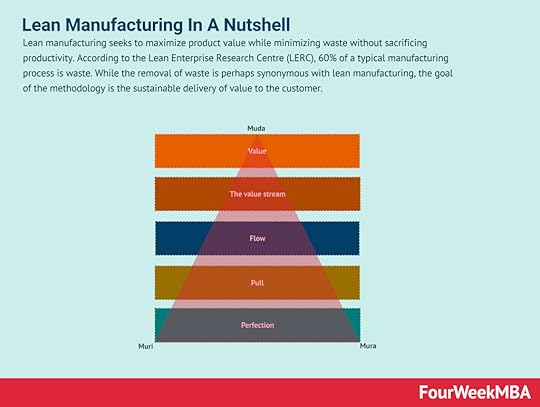 Lean manufacturing seeks to maximize product value while minimizing waste without sacrificing productivity. According to the Lean Enterprise Research Centre (LERC), 60% of a typical manufacturing process is waste. While the removal of waste is perhaps synonymous with lean manufacturing, the goal of the methodology is the sustainable delivery of value to the customer.
Lean manufacturing seeks to maximize product value while minimizing waste without sacrificing productivity. According to the Lean Enterprise Research Centre (LERC), 60% of a typical manufacturing process is waste. While the removal of waste is perhaps synonymous with lean manufacturing, the goal of the methodology is the sustainable delivery of value to the customer.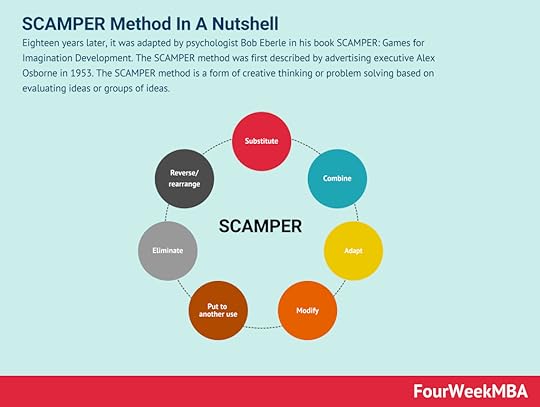 Eighteen years later, it was adapted by psychologist Bob Eberle in his book SCAMPER: Games for Imagination Development. The SCAMPER method was first described by advertising executive Alex Osborne in 1953. The SCAMPER method is a form of creative thinking or problem solving based on evaluating ideas or groups of ideas.
Eighteen years later, it was adapted by psychologist Bob Eberle in his book SCAMPER: Games for Imagination Development. The SCAMPER method was first described by advertising executive Alex Osborne in 1953. The SCAMPER method is a form of creative thinking or problem solving based on evaluating ideas or groups of ideas.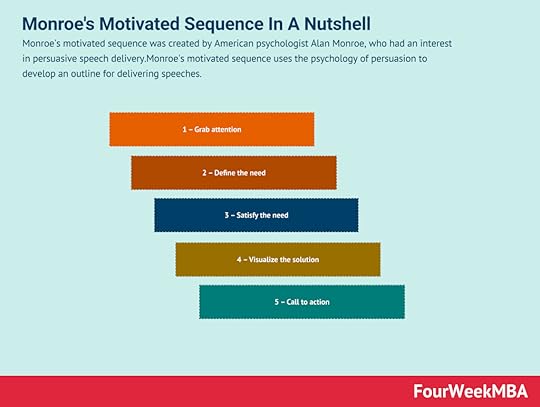 Monroe’s motivated sequence was created by American psychologist Alan Monroe, who had an interest in persuasive speech delivery. Monroe’s motivated sequence uses the psychology of persuasion to develop an outline for delivering speeches.
Monroe’s motivated sequence was created by American psychologist Alan Monroe, who had an interest in persuasive speech delivery. Monroe’s motivated sequence uses the psychology of persuasion to develop an outline for delivering speeches.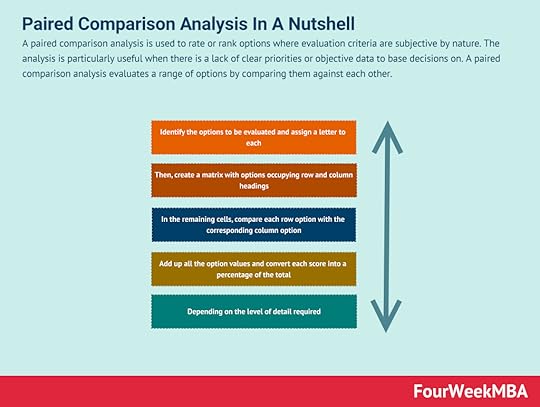 A paired comparison analysis is used to rate or rank options where evaluation criteria are subjective by nature. The analysis is particularly useful when there is a lack of clear priorities or objective data to base decisions on. A paired comparison analysis evaluates a range of options by comparing them against each other.
A paired comparison analysis is used to rate or rank options where evaluation criteria are subjective by nature. The analysis is particularly useful when there is a lack of clear priorities or objective data to base decisions on. A paired comparison analysis evaluates a range of options by comparing them against each other.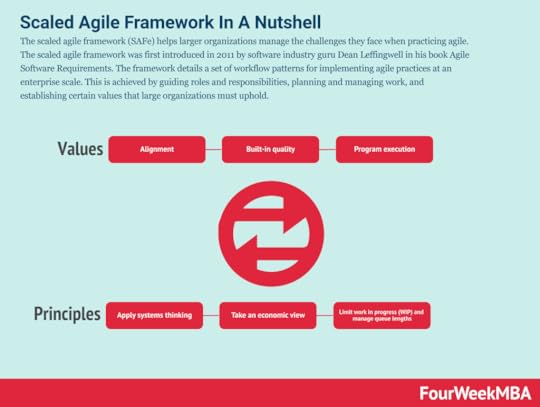 The scaled agile framework (SAFe) helps larger organizations manage the challenges they face when practicing agile. The scaled agile framework was first introduced in 2011 by software industry guru Dean Leffingwell in his book Agile Software Requirements. The framework details a set of workflow patterns for implementing agile practices at an enterprise scale. This is achieved by guiding roles and responsibilities, planning and managing work, and establishing certain values that large organizations must uphold.
The scaled agile framework (SAFe) helps larger organizations manage the challenges they face when practicing agile. The scaled agile framework was first introduced in 2011 by software industry guru Dean Leffingwell in his book Agile Software Requirements. The framework details a set of workflow patterns for implementing agile practices at an enterprise scale. This is achieved by guiding roles and responsibilities, planning and managing work, and establishing certain values that large organizations must uphold.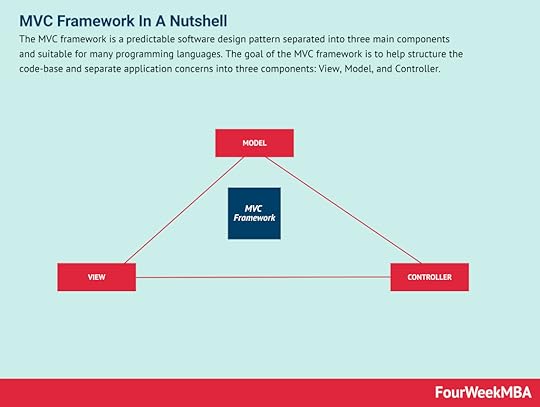 The MVC framework is a predictable software design pattern separated into three main components and suitable for many programming languages. The goal of the MVC framework is to help structure the code-base and separate application concerns into three components: View, Model, and Controller.
The MVC framework is a predictable software design pattern separated into three main components and suitable for many programming languages. The goal of the MVC framework is to help structure the code-base and separate application concerns into three components: View, Model, and Controller. 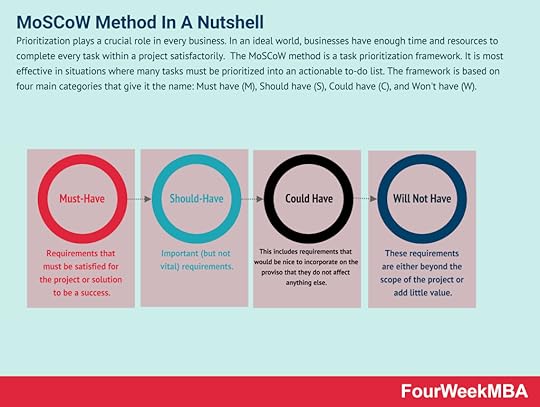 Prioritization plays a crucial role in every business. In an ideal world, businesses have enough time and resources to complete every task within a project satisfactorily. The MoSCoW method is a task prioritization framework. It is most effective in situations where many tasks must be prioritized into an actionable to-do list. The framework is based on four main categories that give it the name: Must have (M), Should have (S), Could have (C), and Won’t have (W).
Prioritization plays a crucial role in every business. In an ideal world, businesses have enough time and resources to complete every task within a project satisfactorily. The MoSCoW method is a task prioritization framework. It is most effective in situations where many tasks must be prioritized into an actionable to-do list. The framework is based on four main categories that give it the name: Must have (M), Should have (S), Could have (C), and Won’t have (W).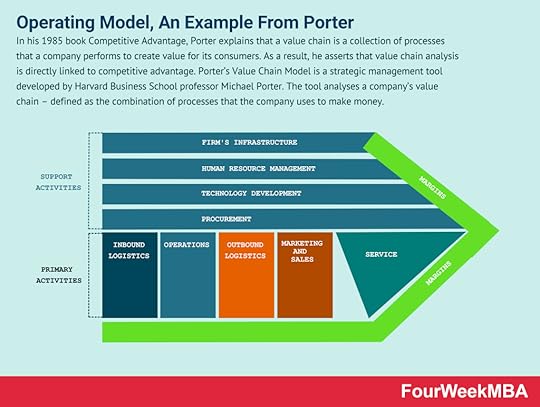 The operating model is a visual representation and mapping of the processes and how the organization delivers value and, therefore, how it executes its business model. Therefore, the operating model is how the whole organization is structured around the value chain to build a viable business model.
The operating model is a visual representation and mapping of the processes and how the organization delivers value and, therefore, how it executes its business model. Therefore, the operating model is how the whole organization is structured around the value chain to build a viable business model. 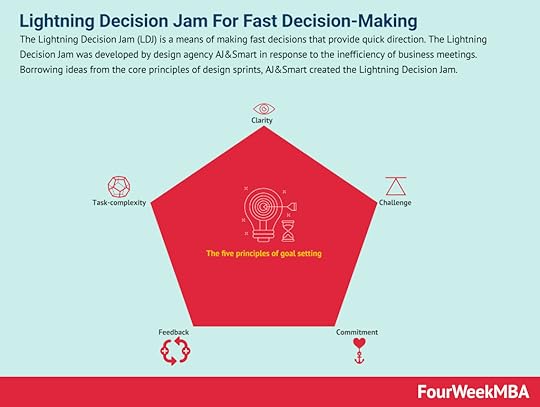 The theory was developed by psychologist Edwin Locke who also has a background in motivation and leadership research. Locke’s goal-setting theory of motivation provides a framework for setting effective and motivating goals. Locke was able to demonstrate that goal setting was linked to performance.
The theory was developed by psychologist Edwin Locke who also has a background in motivation and leadership research. Locke’s goal-setting theory of motivation provides a framework for setting effective and motivating goals. Locke was able to demonstrate that goal setting was linked to performance.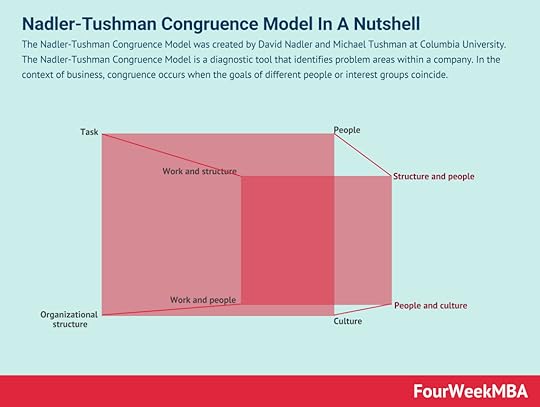 The Nadler-Tushman Congruence Model was created by David Nadler and Michael Tushman at Columbia University. The Nadler-Tushman Congruence Model is a diagnostic tool that identifies problem areas within a company. In the context of business, congruence occurs when the goals of different people or interest groups coincide.
The Nadler-Tushman Congruence Model was created by David Nadler and Michael Tushman at Columbia University. The Nadler-Tushman Congruence Model is a diagnostic tool that identifies problem areas within a company. In the context of business, congruence occurs when the goals of different people or interest groups coincide.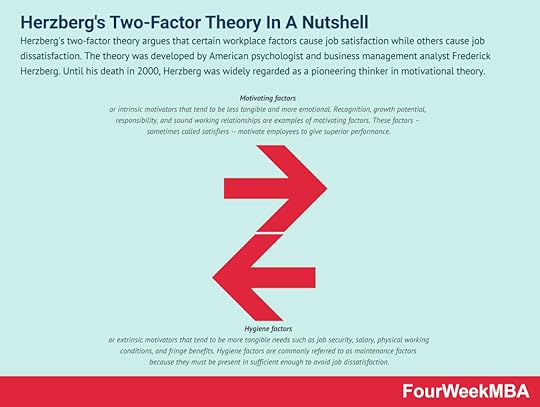 Herzberg’s two-factor theory argues that certain workplace factors cause job satisfaction while others cause job dissatisfaction. The theory was developed by American psychologist and business management analyst Frederick Herzberg. Until his death in 2000, Herzberg was widely regarded as a pioneering thinker in motivational theory.
Herzberg’s two-factor theory argues that certain workplace factors cause job satisfaction while others cause job dissatisfaction. The theory was developed by American psychologist and business management analyst Frederick Herzberg. Until his death in 2000, Herzberg was widely regarded as a pioneering thinker in motivational theory. 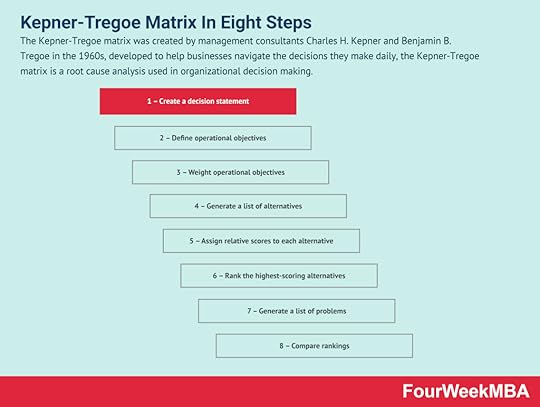 The Kepner-Tregoe matrix was created by management consultants Charles H. Kepner and Benjamin B. Tregoe in the 1960s, developed to help businesses navigate the decisions they make daily, the Kepner-Tregoe matrix is a root cause analysis used in organizational decision making.
The Kepner-Tregoe matrix was created by management consultants Charles H. Kepner and Benjamin B. Tregoe in the 1960s, developed to help businesses navigate the decisions they make daily, the Kepner-Tregoe matrix is a root cause analysis used in organizational decision making.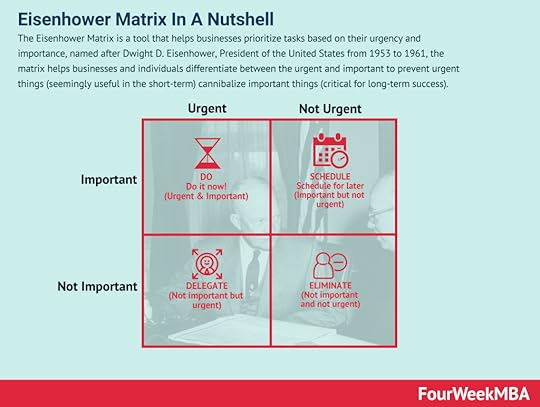 The Eisenhower Matrix is a tool that helps businesses prioritize tasks based on their urgency and importance, named after Dwight D. Eisenhower, President of the United States from 1953 to 1961, the matrix helps businesses and individuals differentiate between the urgent and important to prevent urgent things (seemingly useful in the short-term) cannibalize important things (critical for long-term success).
The Eisenhower Matrix is a tool that helps businesses prioritize tasks based on their urgency and importance, named after Dwight D. Eisenhower, President of the United States from 1953 to 1961, the matrix helps businesses and individuals differentiate between the urgent and important to prevent urgent things (seemingly useful in the short-term) cannibalize important things (critical for long-term success).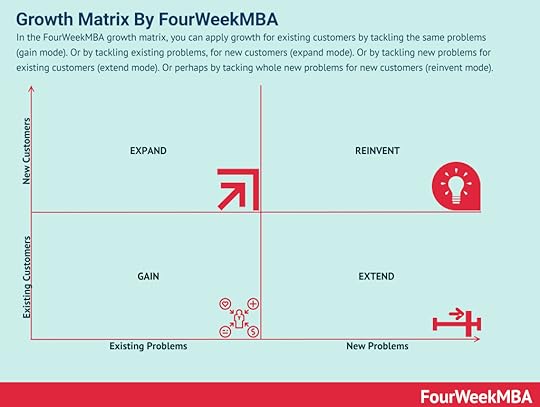 In the FourWeekMBA growth matrix, you can apply growth for existing customers by tackling the same problems (gain mode). Or by tackling existing problems, for new customers (expand mode). Or by tackling new problems for existing customers (extend mode). Or perhaps by tackling whole new problems for new customers (reinvent mode).
In the FourWeekMBA growth matrix, you can apply growth for existing customers by tackling the same problems (gain mode). Or by tackling existing problems, for new customers (expand mode). Or by tackling new problems for existing customers (extend mode). Or perhaps by tackling whole new problems for new customers (reinvent mode).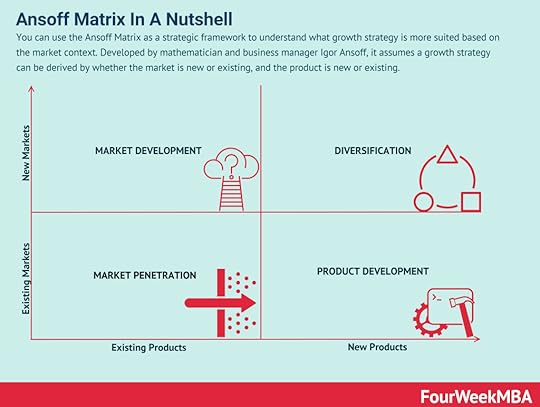 You can use the Ansoff Matrix as a strategic framework to understand what growth strategy is more suited based on the market context. Developed by mathematician and business manager Igor Ansoff, it assumes a growth strategy can be derived by whether the market is new or existing, and the product is new or existing.
You can use the Ansoff Matrix as a strategic framework to understand what growth strategy is more suited based on the market context. Developed by mathematician and business manager Igor Ansoff, it assumes a growth strategy can be derived by whether the market is new or existing, and the product is new or existing.Main Guides:
Business ModelsBusiness StrategyBusiness DevelopmentDistribution ChannelsMarketing StrategyPlatform Business ModelsNetwork Effects
The post Management Tools for Business People appeared first on FourWeekMBA.
Change Management In A Nutshell
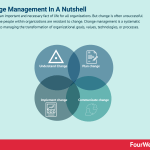
Change is an important and necessary fact of life for all organizations. But change is often unsuccessful because the people within organizations are resistant to change. Change management is a systematic approach to managing the transformation of organizational goals, values, technologies, or processes.
Understanding change management
Indeed, research has found that just 38% of individuals like to leave their comfort zone regularly. For the remaining 62%, change in a workplace setting is met with apprehension. Thoughts may turn to job security or whether they might be required to take on new roles or responsibilities.
Through a range of strategies, change management smooths the transition process for all employees. It is also important in ensuring that businesses remain financially viable long after the change has been implemented.
Change management is useful in a variety of scenarios, including:
Mergers and acquisitions.Crisis management.Change in leadership or leadership style.Improving company culture.Technology implementation.
The four principles of change management
To navigate successful change, a business must focus on four core principles:
Understand change. Decision-makers must first understand the reasons for change before promoting change to subordinates. Benefits of change to the employee and the business should be communicated first and foremost. But it’s also important to stress the costs or negative outcomes of not changing. Ultimately, employees need to feel confident a change initiative is worth the effort.Plan change. Transformation does not happen overnight, nor does it happen by chance. Change strategies should identify the personnel most suited to supporting and mobilizing support for change. The business must also define what successful change looks like by setting appropriate goals. Popular planning tools for change include SIPOC diagrams and the Burke-Litwin Change Model.Implement change. Change measures should be implemented with a sense of urgency incorporating small, achievable wins to build momentum and employee motivation. Each employee should understand what is required of them and be offered support if they are having difficulty in transitioning. Some businesses choose to appoint staff whose primary role is to model new behaviors or actions.Communicate change. Change should be communicated so that it aligns with the company’s mission statement or vision. This “bigger picture” thinking inspires employees to act purposefully, safe in the knowledge that they are contributing to the success of the organization. The ADKAR model provides a helpful framework for communicating change at the individual level.
Consequences of poor change management practices
Businesses that fail to recognize the importance of people in successful change are likely to experience a raft of negative consequences.
Some of the more high-impact consequences are outlined below:
Poor project management. A lack of suitable change management can result in projects running over budget with missed deadlines. In extreme cases, projects fail to deliver and can be abandoned entirely. This is invariably caused by employees with low morale and low productivity because of poorly defined goals or change measures.Employee resignation. Valuable members of staff who experience poor change management at the project and organizational level are more likely to resign. The cost of losing experienced employees is obviously high, but mass departures also create a cultural legacy of failed change which becomes hard to reverse.Incomplete implementation. Change management that ignores people as a key driver is less likely to deliver results or meet outcomes. Goals may include reducing expenses, increasing productivity, capturing market share, or meeting certain regulations. In this scenario, the business is left with a change management plan not fully realized. Without direction, the business is unlikely to recoup costs and move forward without significant difficulty.
Key takeaways
Change management is a systematic, people-centric approach to handling change within an organization.Change management is useful in scenarios where people are less likely to leave their comfort zones. These scenarios include crisis management and a change in leadership change or company culture.The costs of poor change management are high. Businesses are likely to lose experienced employees to other organizations and not be able to recoup project costs if they do not maintain a focus on people.
Main Guides:
Business ModelsBusiness StrategyBusiness DevelopmentDistribution ChannelsMarketing StrategyPlatform Business ModelsNetwork Effects
Main Case Studies:
Amazon Business ModelApple Mission StatementNike Mission StatementAmazon Mission StatementApple Distribution
The post Change Management In A Nutshell appeared first on FourWeekMBA.
Lean Manufacturing In A Nutshell
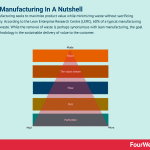
Lean manufacturing seeks to maximize product value while minimizing waste without sacrificing productivity. According to the Lean Enterprise Research Centre (LERC), 60% of a typical manufacturing process is waste. While the removal of waste is perhaps synonymous with lean manufacturing, the goal of the methodology is the sustainable delivery of value to the customer.
Understanding lean manufacturing
Lean manufacturing began with Henry Ford and his philosophy of production line assembly. However, modern lean manufacturing was established by engineers Taiichi Ohno and Eiji Toyoda in the Toyota Production System (TPS).
The TPS seeks to address wastage resulting from three common scenarios:
Muda – or the Japanese term for “waste” encapsulating anything that creates waste or constraints during manufacturing. Toyota defined eight different waste categories: defects, overproduction, waiting, not utilizing talent, transportation, inventory excess, motion waste, and excess processing.Mura – or the Japanese term for “unevenness in operations” that describes any factor creating inefficient or inconsistent workflows. Muri – the Japanese term describing the “overburdening of people and equipment”. These factors cause employee burnout and lead to equipment malfunction, reducing productivity and quality.
The five key principles of lean manufacturing
Businesses wanting to create a culture of lean excellence should consider these principles:
Value. To deliver value to the customer, the business must first define it. How much is the customer willing to pay for a product or service? With this figure, the business creates a top-down target price with which it can determine manufacturing costs.The value stream. This encompasses the entire product life cycle from raw material acquisition to product disposal. The value stream should be mapped out to determine which processes add value and which do not. Any process or product step, feature, or material should be eliminated if it does not add value.Flow. After waste has been removed from the process, the process should be tested to make sure that the remaining value-adding steps flow harmoniously without delays, interruptions, or stoppages.Pull. The fourth principle argues that businesses should adopt Toyota’s “just-in-time” manufacturing philosophy. This means that products should be built-to-order which avoids inefficiencies associated with large amounts of stockpiled materials.Perfection. Lean manufacturing advocates continuous improvement. Although perfection is an ideal, businesses that relentlessly strive toward it have an advantage over their competitors. They also become more productive and adaptable to change.
Useful lean manufacturing tools
Since the implementation of the Toyota Production System, many tools and methodologies have been developed for use beyond the automotive industry.
Here are three of the most common:
The 5S System – which is a tool for organizing materials for quick access and improved maintenance. The 5S system details the effective and efficient reorganization of a workspace. It is also ideal for businesses that experience waste from poorly maintained tools and equipment. Kaizen – this tool is one of continuous observation and incremental improvement. Kaizen argues that employees and managers should work toward reducing waste, as their combined skills and expertise creates a collaborative and highly effective approach. Plan, Do, Check, Act (PDCA) – a four-step iterative process utilizing the scientific method to facilitate the continuous improvement of processes and products.
Key takeaways
Lean manufacturing focuses on reducing waste from manufacturing processes and adding customer value without sacrificing productivity.Lean manufacturing is based on the Toyota Production System which describes the creation of waste according to three common scenarios.Lean manufacturing has applications beyond the automotive industry. Several tools have been developed to help businesses implement lean principles. These include the 5S System and Kaizen.
Read Next: Agile Methodology, Lean Methodology, Agile Project Management, Scrum, Kanban, Six Sigma.
Main Guides:
Business ModelsBusiness StrategyBusiness DevelopmentDistribution ChannelsMarketing StrategyPlatform Business ModelsNetwork Effects
Main Case Studies:
Amazon Business ModelApple Mission StatementNike Mission StatementAmazon Mission StatementApple Distribution
The post Lean Manufacturing In A Nutshell appeared first on FourWeekMBA.
Zachman Framework In A Nutshell
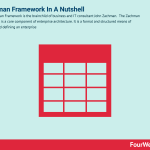
The Zachman Framework is the brainchild of business and IT consultant John Zachman. The Zachman Framework is a core component of enterprise architecture. It is a formal and structured means of viewing and defining an enterprise.
Understanding the Zachman Framework
Zachman created the framework in response to the difficulty that many large and complex businesses have in managing change. Indeed, many do not understand their own organizational structure. Many others do have this knowledge, but the information is confined to individual employees or departments and is not freely available.
The Zachman framework is a means of classifying organizational architecture. It considers the pre-existing functions, elements, and processes of a business so that decision-makers can proactively manage change.
Importantly, the framework is an enterprise ontology that shows an organization and its information systems from different perspectives. It is not a methodology that can be followed to produce a desired result.
The structure of the Zachman Framework
The Zachman Framework is a two-dimensional classification scheme in the form of a 36-cell matrix, with each cell focusing on one perspective or dimension of the enterprise.
Columns in the matrix represent interrogatives, or questions that are asked of the enterprise:
What (data) – what data or information is required to institute change or carry out a project?How (function) – how does the business work? What are its processes?Where (network) – where does the business operate?Who (people) – who runs the business? What are the business units and how are they structured?When (time) – when does the business perform its processes? What are the schedules and workflows?Why (motivation) – what motivates the business to choose one solution over another? How was the solution arrived at?
Rows in the matrix represent the perspectives of key stakeholders who are involved with change and are ordered according to priority.
Combining all six cells in one row gives a holistic representation of that enterprise according to one (or each) of the following perspectives:
Planner’s view (Scope contexts) – or the purpose and strategy of the business that defines the arena for the other views.Owner’s view (Business concepts) – the structure, functions, and organization of the business. This gives insight into areas that might be automated.Designer’s view (System logic) – how will the system satisfy the informational needs of the business? Ignore solution specific aspects or production constraints.Implementer’s view (Technology physics) – or how the system will be implemented. What role will technology play in creating solutions or alleviating production constraints?Sub-constructor’s view (Component assembles) – what are the specific details that need to be clarified before production can begin? Since this view is more concerned with a part of a system and not the whole, it is sometimes considered less important.User’s view (Operations classes) – or the view of a functioning system within its respective operational environment.
Key takeaways
The Zachman Framework is a formal and structured means of helping large organizations manage change through information sharing.The Zachman Framework is an enterprise ontology. It is not a methodology that offers explicit advice on how change should be managed.The Zachman Framework is a two-dimensional classification scheme represented by a 36-cell matrix. Rows in the matrix represent six key stakeholder perspectives, while columns represent interrogatives that help an enterprise clarify every aspect of its operations.
Main Guides:
Business ModelsBusiness StrategyBusiness DevelopmentDistribution ChannelsMarketing StrategyPlatform Business ModelsNetwork Effects
Main Case Studies:
Amazon Business ModelApple Mission StatementNike Mission StatementAmazon Mission StatementApple Distribution
The post Zachman Framework In A Nutshell appeared first on FourWeekMBA.
Circular Flow Model In A Nutshell
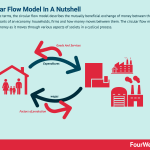
In simplistic terms, the circular flow model describes the mutually beneficial exchange of money between the two most vital parts of an economy: households, firms and how money moves between them. The circular flow model describes money as it moves through various aspects of society in a cyclical process.
Understanding the circular flow model
Households – whose primary function is to supply firms with production factors. The 4 factors of production are land, enterprise, real capital, and human capital and each is supplied by factor owners in exchange for a reward. For example, land is supplied by landowners, human capital is supplied by labor, and capital is supplied by capital owners. Entrepreneurs, who absorb enterprise production risks, combine land, human capital, and real capital.Firms – whose primary function is to supply goods and services to households and other firms. This is achieved by paying for the services of the abovementioned factors.
Money moves between households and firms in a cyclical process whenever a transaction takes place. Transactions are attributed to factor incomes. For example, human capital receives a wage in exchange for labor. Land receives rent and real capital receives a rate of return.
Firms also inject money into the circular flow model through production function.
A simple production function (Q) formula argues that output is a function (f) of factor inputs, where Q = f (L, La, K).
Where:
L = landLa = labor, andK = capital.
Consumer spending in the circular flow model
Another way to think of the circular flow model is by considering income and spending. In this case, money flows in the opposite direction to that of goods and services and production factors.
Here is how it works:
When a household wants to purchase a good or service, money flows toward the product market. Most understand this process as consumer spending.The product market then purchases goods and services from businesses to provide them to households. This generates revenue.To manufacture or provide goods and services for the product market, the business must purchase resources from the resource market. This is a cost to the business.With resources acquired, the business must pay workers and landowners to create goods and services in the form of income. This income is then used by the household to purchase goods and services, thereby restarting the process.
Other key factors in the circular flow model
Supply and demand rarely occur in a vacuum. Indeed, simplistic circular flow models omit other key drivers of economic systems.
These include:
Government – an important player because of its ability to inject and remove money from the flow. Government spending can be directed toward the product market (a new highway) and the resource market (teachers, fuel, or electricity). Governments also remove money from the flow (“leakage”) through sales, income, or property taxes.Financial institutions – banks also contribute to leakage by encouraging households and businesses to save their money with higher interest rates. They can also inject money into the circular flow model in the form of loans and interest rate cuts.Foreign sector – through imports, the foreign sector injects goods but leaks income because goods are manufactured offshore. However, this is at least partially offset by exports, which leak goods but injects income.
Key takeaways
In simple terms, the circular flow model illustrates the cyclical flow of money as it moves between households and firms.The circular flow model of consumer income and spending moves in the opposite direction to the classic model incorporating goods and services and production factors.Many circular flow models omit important players, such as government, banks, and the foreign sector. Each has the ability to inject and remove money or goods and services from the process.
Main Guides:
Business ModelsBusiness StrategyBusiness DevelopmentDistribution ChannelsMarketing StrategyPlatform Business ModelsNetwork Effects
Main Case Studies:
Amazon Business ModelApple Mission StatementNike Mission StatementAmazon Mission StatementApple Distribution
The post Circular Flow Model In A Nutshell appeared first on FourWeekMBA.
December 16, 2020
Best Books For Starting A Business In 2021
This is the most advanced guide on business models that you can find. An over 770 pages ebook, covering many case studies, practical analyses, systems, and business models.
Through this master book, you can learn, improve your business acumen, and borrow parts of those models, to test them out to build, grow, or scale a business. Or simply have an advanced understanding of the business world, even if you’re starting from scratch.
Master 100 business models dominating our times. A master guide from FourWeekMBA, in ebook format, to be consumed at your own pace!
In the last years, I’ve been dissecting business models of any type, and companies of any size. At the same time, I’ve been talking, interviewing, and discussing business models and business model innovation with dozens of entrepreneurs and practitioners.
I’ve been doing that for several reasons:
To gain a better understanding of the businesses around me. As I had the option to gain a Ph.D. on the topic or to create my Ph.D. I went for the latter, and in the process, I thought to document it all on FourWeekMBA. Over time I wanted to create the business school I always dreamed of.
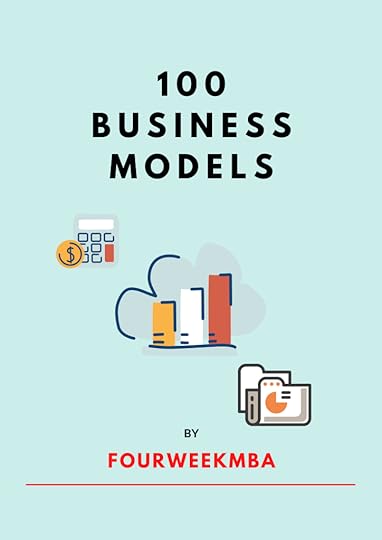
100 Strategy Tools
The business world is extremely noisy.
So how do we make sense of it?
The path ahead for better decision-making for many is about using complex models and searching for more data. However, there is also another approach.
That is about reducing complexity, by using strategy tools for your business.
In this book you will find a complete list of tools and frameworks you can use for business, thoroughly explained!
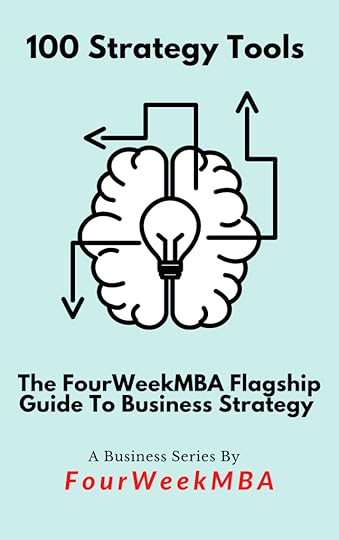
An Entire MBA In Four Weeks
An Entire MBA in Four Weeks brings you thorough a journey to master the business world, as quickly as possible:
Week One: Mastering The Financial GameWeek Two: Business Model EngineeringWeek Three: Mastering The Customers Week Four: Growth And DistributionWeek Five: Take Action With The M.O.V.E. Framework
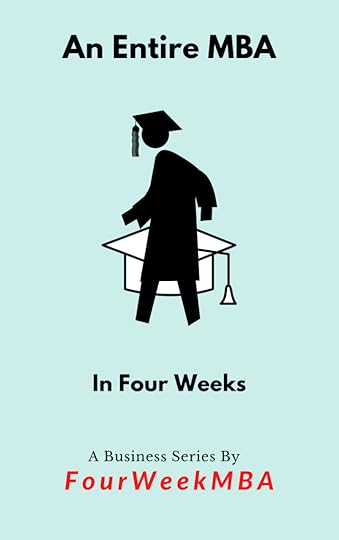
BizBooks On Demand by FourWeekMBA
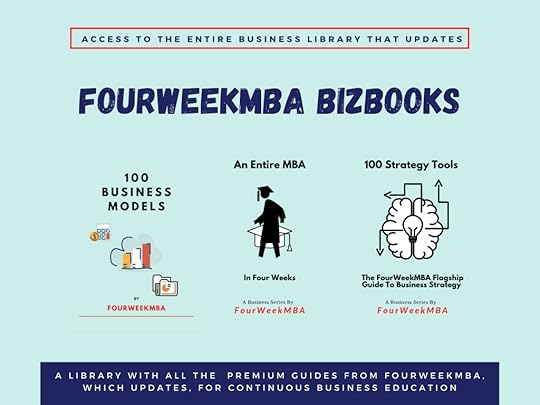
The post Best Books For Starting A Business In 2021 appeared first on FourWeekMBA.
December 15, 2020
Full Stack Vs. DevOps
DevOps is a conjugation of the term “development” and “operations” to emphasize how functions integrate across IT teams. DevOps strategies promote seamless building, testing, and deployment of products. It aims to bridge a gap between development and operations teams to streamline the development altogether. Full-stack development represents the ability to operate and design at both user interface level and back-end level and, therefore, a programmer with the full skill set to perform all functions to bring web apps to life.
 There are three segments of web development and design. One is dealing with the user interface or what the customer sees. Front End development is responsible for the crucial elements that make up the presentation of the page. The next is Back End, which handles the processes involved in the web page. It deals with information validation, database management, as well as transactions. As businesses continue to grow, the third segment emerged to accommodate their increasing needs and lucrative goals. Building applications from end-to-end is what makes a full stack developer. It is a more versatile role that is considered the Jack of All Trades.
There are three segments of web development and design. One is dealing with the user interface or what the customer sees. Front End development is responsible for the crucial elements that make up the presentation of the page. The next is Back End, which handles the processes involved in the web page. It deals with information validation, database management, as well as transactions. As businesses continue to grow, the third segment emerged to accommodate their increasing needs and lucrative goals. Building applications from end-to-end is what makes a full stack developer. It is a more versatile role that is considered the Jack of All Trades. DevOps refers to a series of practices performed to perform automated software development processes. It is a conjugation of the term “development” and “operations” to emphasize how functions integrate across IT teams. DevOps strategies promote seamless building, testing, and deployment of products. It aims to bridge a gap between development and operations teams to streamline the development altogether.
DevOps refers to a series of practices performed to perform automated software development processes. It is a conjugation of the term “development” and “operations” to emphasize how functions integrate across IT teams. DevOps strategies promote seamless building, testing, and deployment of products. It aims to bridge a gap between development and operations teams to streamline the development altogether.Read Next: Full-Stack Development, DevOps, DevSecOps.
Main Guides:
Business ModelsBusiness StrategyMarketing StrategyPlatform Business ModelsNetwork Effects In A Nutshell
The post Full Stack Vs. DevOps appeared first on FourWeekMBA.
December 14, 2020
Operating Model
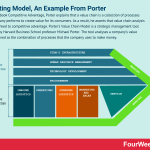
The operating model is a visual representation and mapping of the processes and how the organization delivers value and, therefore, how it executes its business model. Therefore, the operating model is how the whole organization is structured around the value chain to build a viable business model.
Porter’s Value Chain
Porter for instance helps visualize the value chain and how the whole organizaiton is structured around it.
 In his 1985 book Competitive Advantage, Porter explains that a value chain is a collection of processes that a company performs to create value for its consumers. As a result, he asserts that value chain analysis is directly linked to competitive advantage. Porter’s Value Chain Model is a strategic management tool developed by Harvard Business School professor Michael Porter. The tool analyses a company’s value chain – defined as the combination of processes that the company uses to make money.
In his 1985 book Competitive Advantage, Porter explains that a value chain is a collection of processes that a company performs to create value for its consumers. As a result, he asserts that value chain analysis is directly linked to competitive advantage. Porter’s Value Chain Model is a strategic management tool developed by Harvard Business School professor Michael Porter. The tool analyses a company’s value chain – defined as the combination of processes that the company uses to make money.Organizational Structure
The organizational structure also determines how the company can deliver value.
 An organizational structure allows companies to shape their business model according to several criteria (like products, segments, geography and so on) that would enable information to flow through the organizational layers for better decision-making, cultural development, and goals alignment across employees, managers, and executives.
An organizational structure allows companies to shape their business model according to several criteria (like products, segments, geography and so on) that would enable information to flow through the organizational layers for better decision-making, cultural development, and goals alignment across employees, managers, and executives. Distribution Channels
Also, the distribution side, so how sales and marketing are organized to produce value is critical. Perhaps, an organization selling an enterprise solution will structure its distribution around a qualified salesforce. A company selling a consumer-facing product will structure its organization more toward marketing instead.
 A distribution channel is the set of steps it takes for a product to get in the hands of the key customer or consumer. Distribution channels can be direct or indirect. Distribution can also be physical or digital, depending on the kind of business and industry.
A distribution channel is the set of steps it takes for a product to get in the hands of the key customer or consumer. Distribution channels can be direct or indirect. Distribution can also be physical or digital, depending on the kind of business and industry.Marketing Mix
The various marketing channels the company will use to build its brand, and sell its product will also determine the way the operating model delivers value.
 The marketing mix is a term to describe the multi-faceted approach to a complete and effective marketing plan. Traditionally, this plan included the four Ps of marketing: price, product, promotion, and place. But the exact makeup of a marketing mix has undergone various changes in response to new technologies and ways of thinking. Additions to the four Ps include physical evidence, people, process, and even politics.
The marketing mix is a term to describe the multi-faceted approach to a complete and effective marketing plan. Traditionally, this plan included the four Ps of marketing: price, product, promotion, and place. But the exact makeup of a marketing mix has undergone various changes in response to new technologies and ways of thinking. Additions to the four Ps include physical evidence, people, process, and even politics.Financial Structure
And accordingly the financial model will also determine how the company acquires the financial resources for the operating model, and therefore build a viable business model.
 In corporate finance, the financial structure is how corporations finance their assets (usually either through debt or equity). For the sake of reverse engineering businesses, we want to look at three critical elements to determine the model used to sustain its assets: cost structure, profitability, and cash flow generation.
In corporate finance, the financial structure is how corporations finance their assets (usually either through debt or equity). For the sake of reverse engineering businesses, we want to look at three critical elements to determine the model used to sustain its assets: cost structure, profitability, and cash flow generation. Main Guides:
Business ModelsBusiness StrategyMarketing StrategyPlatform Business ModelsNetwork Effects In A Nutshell
The post Operating Model appeared first on FourWeekMBA.
December 13, 2020
Copywriting vs. Content Marketing
Copywriting has the precise scope of writing text to enable users/potential customers to take a certain action. On the other hand, content marketing usually has a broader scope from the top of the funnel (branding and awareness) to the funnel’s middle and bottom (actions and conversions). Therefore, the primary difference is on the scope: copywriting looks at persuading potential customers to take action, and content marketing can be used for branding or reach.
 Writing a copy is the art of crafting catchy texts to persuade a particular demographic. “A copy” is the written content aimed at converting impressions to clicks and converting clicks to high sales. Any form of writing that persuasively requests an action from your audience is called copywriting.
Writing a copy is the art of crafting catchy texts to persuade a particular demographic. “A copy” is the written content aimed at converting impressions to clicks and converting clicks to high sales. Any form of writing that persuasively requests an action from your audience is called copywriting.  Content marketing is one of the most powerful commercial activities which focuses on leveraging content production (text, audio, video, or other formats) to attract a targeted audience. Content marketing focuses on building a strong brand, but also to convert part of that targeted audience into potential customers.
Content marketing is one of the most powerful commercial activities which focuses on leveraging content production (text, audio, video, or other formats) to attract a targeted audience. Content marketing focuses on building a strong brand, but also to convert part of that targeted audience into potential customers.Read Next: Copywriting, Content Marketing, Marketing Mix, Distribution Channels.
Main Guides:
Business ModelsBusiness StrategyMarketing StrategyPlatform Business ModelsNetwork Effects In A Nutshell
The post Copywriting vs. Content Marketing appeared first on FourWeekMBA.
Top Must-Read Paul Graham Essays
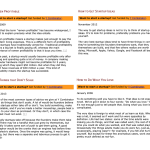
Entrepreneur, computer scientist, and venture capitalist Paul Graham is one of the most interesting and brilliant minds to follow in the startup world. He co-founded the accelerator Y Combinator and Hacker News; he also backed up many successful startups that turned into successful tech companies (like Airbnb).
On Scalability
Actually startups take off because the founders make them take off. There may be a handful that just grew by themselves, but usually it takes some sort of push to get them going. A good metaphor would be the cranks that car engines had before they got electric starters. Once the engine was going, it would keep going, but there was a separate and laborious process to get it going.
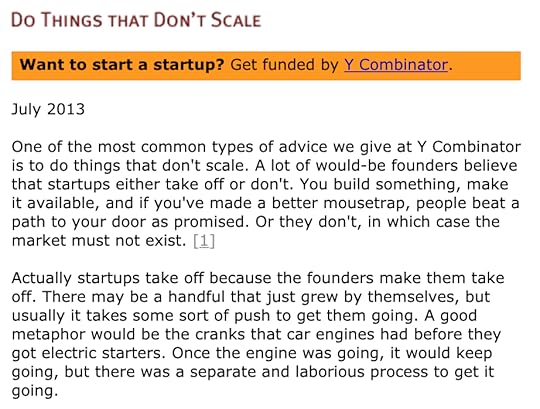 Source: paulgraham.com/ds.html
Source: paulgraham.com/ds.htmlOn Startup Ideas
The very best startup ideas tend to have three things in common: they’re something the founders themselves want, that they themselves can build, and that few others realize are worth doing. Microsoft, Apple, Yahoo, Google, and Facebook all began this way.
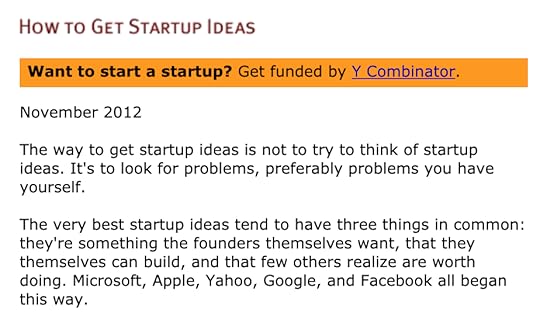 Source: paulgraham.com/startupideas.html
Source: paulgraham.com/startupideas.htmlOn Doing What You Love
There’s another sense of “not everyone can do work they love” that’s all too true, however. One has to make a living, and it’s hard to get paid for doing work you love. There are two routes to that destination:
The organic route: as you become more eminent, gradually to increase the parts of your job that you like at the expense of those you don’t.
The two-job route: to work at things you don’t like to get money to work on things you do.
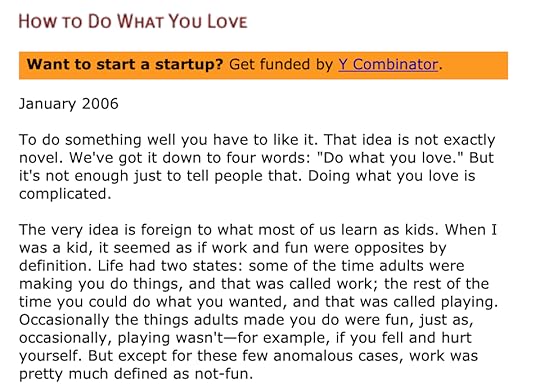 Source: paulgraham.com/love.html
Source: paulgraham.com/love.htmlOn Ramen Profitability
Ramen profitable means a startup makes just enough to pay the founders’ living expenses. This is a different form of profitability than startups have traditionally aimed for. Traditional profitability means a big bet is finally paying off, whereas the main importance of ramen profitability is that it buys you time.
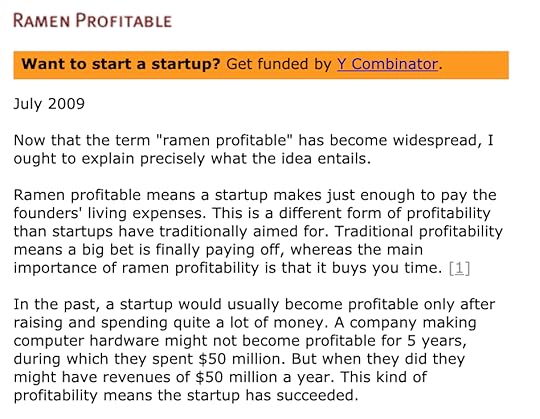 Source: paulgraham.com/ramenprofitable.html
Source: paulgraham.com/ramenprofitable.htmlRead Next: Ramen Profitability, Profitability, Idea Generation.
Main Guides:
Business ModelsBusiness StrategyMarketing StrategyBusiness Model InnovationPlatform Business ModelsNetwork Effects In A NutshellDigital Business Models
The post Top Must-Read Paul Graham Essays appeared first on FourWeekMBA.



